Alaska Economic Trends
Alaska Economic Trends is a monthly magazine that covers a range of economic topics.
Sign up for a free electronic subscription. 
Sign up for a paid print subscription.
Alaska Economic Trends are searchable from 1961 to the present using the Trends search page. The search can include any combination of the following: Key Words, Date Range, Author, Category
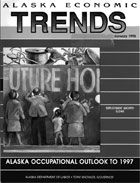
Alaska employment is projected to increase at an annual average rate of 1.2%, from 265,396 to 281,014, between 1992 and 1997. Nearly 9,400 job openings are projected annually during this five-year period. Projected annual job openings are the combined result of employment growth and net separations from the occupation and do not include jobs resulting from employee turnover.
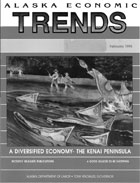
The last Alaska Economic Trends article on the Kenai Peninsula Borough (March 1990) focused on a recovering economy led by a wide variety of industries. These positive growth trends have continued across many sectors. Fishing, tourism, oil and gas production and refining, and government continue to be the backbone of the local economy. The economy's strongest asset is its diversification.
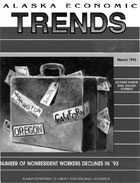
Against the backdrop of an outstanding year (1993) for employment and earnings in Alaska, the number ofworking nonresidents1 declined for the first time since 1987. (See Figure 1.) While the decrease was small, 2.9 percent or about 2,300 workers less than 1992, the fact it happened at all is significant. Practically every industry sector was fueling Alaska's economy during 1993 with noteworthy contributions by construction, services and retail trade. Overall, there were 5,300 more wage and salary workers employed at some time in Alaska in 1993 than were employed in 1992. Based on the experience of the prior six years, it was expected that the percent nonresident workers would have increased, or at the very least, held it's own.
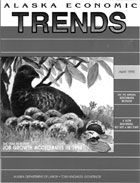
Pushed by a retail boom, Alaska's economy grew for the seventh straight year in 1994. Wage and salary job growth accelerated from the 2.3% pace set in 1993 to 2.8% in 1994, despite oil industry layoffs and timber industry plant closures. This was the second straight year of faster job growth, reversing a trend that marked the early part of the decade.
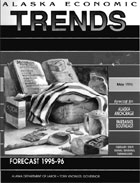
Alaska's economy will continue to grow during 1995 and 1996, extending the trend of job gains for two more years. Expansion keyed to tourism, retail, construction and hard rock mining best describes Alaska's current economic outlook. Conversely, employment in Alaska's oil and forest products industries will continue to contract. In addition, Alaska's public sector will shed employees as pressure to downsize government on all levels builds.

How expensive is it to live in Alaska? How much has Alaska's cost of living increased? These are two of the most frequently asked questions of the Alaska Department of Labor's Research and Analysis section. In answer to these questions, this article provides some of the latest cost of living measurements available for Alaska and explains the uses and limitations of these data.

The Alaska New Hires Quarterly Report is a new series developed by the Alaska Department of Labor, Research and Analysis Section. A new hire is defined as an employee who was not working for the employer during any of the previous four quarters. In other words, a new hire represents either a new job or the turnover of an existing job, excluding seasonal rehires from the previous year. New hires include workers entering the work force for the first time; workers re-entering the work force after training, education, or child-rearing; previously unemployed individuals who find work with a new employer; and individuals who change employers while making a vertical or lateral career move.
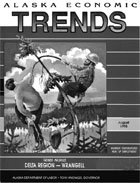
Delta is located at the iunction of the Richardson and Alaska highways, approximately 100 miles southeast of Fairbanks. Exact boundaries of the area are not readily identifiable, but for the purposes of this article the Delta region includes the city of Delta Junction, Big Delta, Ft. Greely, the Clearwater area and Healy Lake. Its northern and southern boundaries are the Fairbanks North Star Borough and Healy Lake.

The Carrs grocery chain once again led Alaska's list of the top 100 private sector employers-in fact it remains the only private sector employer which has more than 3,000 employees. And it is likely to keep that distinction for the foreseeable future.

The Alaska Department of Labor's Research and Analysis Section (AKDOL/R&A) periodically collects benefits data from Alaska private employers. During the summer of 1993, R&A mailed questionnaires to employers asking them to report the benefits they provide their employees. This benefits survey was conducted in conjunction with the annual Alaska wage rate survey.

Over 20,000 people work in Alaska's health care industry,making it one of the state's biggest employers. Employment in the health care industry is greater than in the oil industry, all of the state's eating establishments, the timber industry, or the state's entire finance sector. In fact, it employs about the same number of people as civilians in the federal government. According to the University of Alaska Anchorage, 50 percent more money is spent on health care than on Alaska's public schools, and nearly as much is spent on health care as operating the military in the state. Expenditures for this industry could reach $2.4 billion in 1995.
